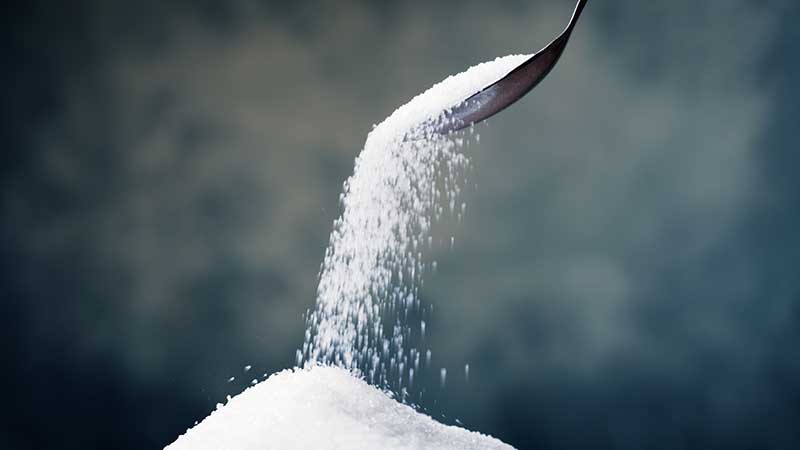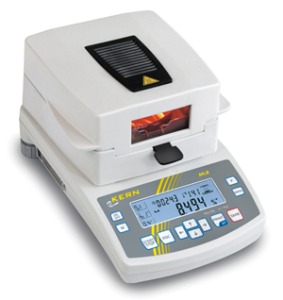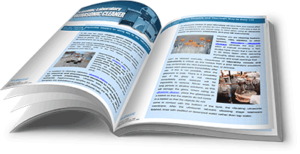Moisture Analyzers
How to Determine Moisture Content
Moisture content – the amount of moisture contained in a product – can be determined by using a moisture analyzer. Specifications for correct moisture content span a host of industries and products. Here you will learn how moisture analyzers are employed by researchers, QC personnel, professional associations, and government agencies to ensure products meet moisture content specs. It includes info on how moisture analyzers work along with purchasing and operating tips.
Why Moisture Content is Critical
According to Title 21 of the Code of Federal Regulations section n, “Safe-moisture level is a level of moisture low enough to prevent the growth of undesirable microorganisms in the finished product under the intended conditions of manufacturing, storage, and distribution.”
Types of Moisture
While most folks think of moisture as water, moisture is anything that evaporates on heating. Examples include fats, oils, alcohol, and solvents.
Moreover, moisture can lurk in places you … Read the rest
Determining and Confirming Moisture Content in Food
As reported in Wikipedia, “Food moisture analysis involves the whole coverage of the food items in the world because foods are comprising a considerable amount of water rather than other ingredients.” Food Technology notes “Both moisture content and water activity… are important in formulating products for safety and stability.” This post describes how benchtop moisture analyzers are critical tools to determine and confirm correct moisture content in food.
What is Moisture Content?
Moisture content applies to much more than food. Here is a brief explanation of the various forms of moisture that applies across the board:
- On the surface of a sample. This can be defined as bulk water attracted to other substances. Even though you might not see it, it can be there and its presence affects the weight of the substance. Surface moisture is most easily removed in a moisture analyzer.
- In pores or capillaries, where it
Selection Tips for Moisture Analyzers
If you are shopping for a moisture analyzer and feel stymied by the number of choices, these moisture analyzer selection tips should help.
Moisture balance selection criteria are based on factors including:
- Resolution or the smallest difference that can be read on the display. This is also termed readability or readout.
- Repeatability – the ability of a moisture balance to display the same result when the same sample is tested repeatedly. Expressed as a standard deviation.
- Features important to performing moisture analysis. These are based on the characteristics of product being analyzed such as those require special heating profiles.
- Specialized capabilities such as testing products with extremely low moisture content specs, providing graphic displays of changing moisture content, and building libraries of frequently performed tests.
Four Candidate Moisture Analyzers
Tovatech offers several models of moisture analyzers from which researchers or QC personnel can select the most cost-effective solution to their … Read the rest
Choosing a Moisture Analyzer for Sludge Dewatering Operations
Moisture content is a critical criterion to determine the acceptability of treated sewage sludge (called biosolids or sludge cake) as an acceptable product for use as a fuel and a nutrient-rich organic material. Moisture analyzers play a vital role in quality control procedures at sludge dewatering plants.
After the brief intro our post explains two options for moisture analysis at these plants.
A Brief Intro to Sludge Dewatering at Sewage Treatment Plants
Improved wastewater treatment processes separate sewage sludge, called cake, as a usable biomass from water that must meet regulated levels of purity before being discharged into water courses.
For the cake to be useable its moisture content must be known to within 0.5 – 1%. This knowledge helps operators to control the drying process that turns biomass into a fuel. Industrial-scale dryers are used in this operation. As you might imagine, the lower the moisture content the more … Read the rest
How to use a Moisture Analyzer for Liquid Products
At first it might seem that determining moisture content in liquids is a contradiction in terms. After all, liquids are moisture, right? But think of the difference in taste between a quality brand of vegetable juice and the watered-down taste of a bargain brand. That’s why processors of quality liquid products such as juices and syrups use a moisture analyzer to determine if their product meets their own and industry standards.
Drying ovens to remove excess moisture are part of the processing steps in preparing products such as vegetable juices. But spot-checks using a moisture analyzer should be made prior to packaging. Also called moisture balances, these devices consist of a halogen heater mounted on a precision analytical balance. They are programmed to determine moisture content by the thermogravimetric process and display loss of weight on drying (LOD). “Drying” might seem a misnomer here because the liquid is never fully … Read the rest
Use a Moisture Analyzer for Wood Pellet Quality Control
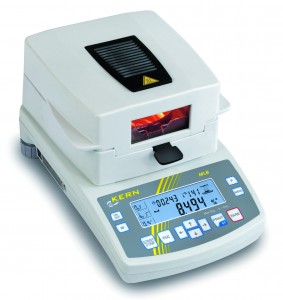
Wood pellets are becoming more popular as an alternative or supplementary source of heat in many homes and businesses across the land. The Pellet Fuel Institute in October 2011 issued its “Standard Specification for Residential/Commercial Densified Fuel” including recommended moisture content for premium, standard and utility grade wood pellets. A compact moisture analyzer can be used to spot-check moisture content during pellet processing steps.
The Wood Pellet Manufacturing Cycle
A typical 40-pound bag of wood pellets originates as hard- or softwood sawdust, chips, waste materials from furniture and floor manufacturing – virtually any source of wood including trees unsuitable for other uses. The stock is processed to a uniform size with a moisture content of about 13% to 16% prior to the pelletizing operation. Pelletizing is accomplished under high temperatures (~200 ˚F) and pressure (~ 45,000 psi) during which the lignin in the wood serves to bind the particles together … Read the rest
How to Use Moisture Analyzers for Grain & Flour Quality Control
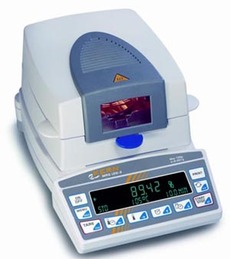
Moisture content, defined as the percentage of a product’s weight due to water, is an essential measure of quality control. A gravimetric moisture analyzer is employed across a broad spectrum of industries to confirm that moisture content is in line with regulations governing a particular industry.
Agricultural products such as grains and the flour derived from grains provide an illustration of where a moisture analyzer is put into play. A University of Minnesota Extension Report, for example, states that wheat and barley grain must have a moisture content of 13% to 14% for safe storage. Achieving that target can be costly and time consuming in wet weather.
When wheat is milled to flour another target applies. A study at the Institute of Food Science and Technology, University of Agriculture, Faisalabad, Pakistan, reports … Read the rest
How to Develop Moisture Analysis Methods
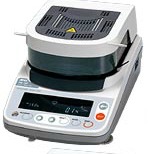
Many of our posts on using a moisture analyzer to check on moisture content provide examples of conducting a moisture analysis for a specific product. The importance of proper moisture content is described in our post on why moisture content matters. But how is a moisture analysis method developed?
Several analyses may be made by researchers in order to identify the parameters to apply for a specific product such as plastic pellets, sugar, body lotion and bread crumbs. Among the testing parameters to be identified are included:
• Sample size. Usually in grams, but how much should be used for the analysis?
• Sample protection. Certain products may require being placed on and/or covered by fiberglass filters.
• Drying temperature. Too hot or not hot enough may skew results.
• Drying profile. This relates to how heat is applied to the … Read the rest
Why Moisture Content Matters
Moisture content, as we have pointed out in many of our posts, is important for a variety of reasons, many of which have to do with quality control, product shelf life and fair pricing. Controlling moisture content can occur at several points along the processing line and usually involves the use of drying ovens, some of which are equipped with moisture sensing devices to reduce the percentage of moisture to target levels. Moisture levels are set by industry and trade associations, and by government agencies. It is up to manufacturers to verify moisture content.
Picking up on our opening sentence, an example of moisture’s effect on quality is exemplified by products as basic as sugar, table salt and bagged cement. All three are hygroscopic – exhibiting a tendency to absorb moisture. A target moisture standard for sugar is 11.9%, … Read the rest
Use a Portable Halogen Moisture Analyzer to Save Money
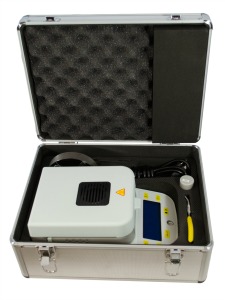
If you perform moisture analysis at more than one location in your facility you’ll soon see the value in the IL 50.001 halogen moisture analyzer now available from Tovatech. What makes it attractive is its portability – instead of buying multiple halogen moisture analyzers simply pack the IL 50.001 in its custom carrying case and take it to the test location.
Moreover, you’ll find this 50 g capacity moisture balance easy to use because programming choices have been confined to the basics – a feature that has a side benefit in terms of attractive pricing.
Superior Performance in a Halogen Moisture Analyzer
Attractive pricing is not at the “expense” of superior performance in this compact, 5-pound 120-volt moisture analyzer. Only 6.5” wide, 11” deep and 5” high, it offers the following performance specs:
- Readability: 0.001 g, 0.01% moisture
- Repeatability: 0.3% (3 g

